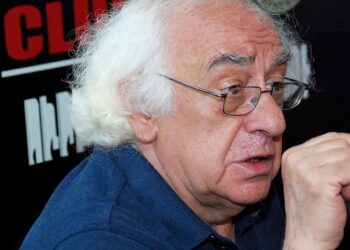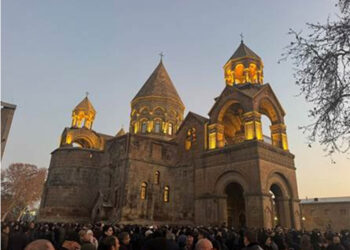Similarly, after surviving the Stalinist terror and the devastation of World War II, as Armenia began a full process of industrialization and cultural recovery, the earthquake of 1988, once again in Gyumri, devastated two thirds of the country.
As if that were not enough, the tragedy was doubled and even tripled with concurrent political and historic events. Indeed, while Armenia lay in ruins and “brotherly” cooperation with other Soviet Republics had begun the painful process of reconstruction, the Soviet Union collapsed before making good on its pledge to help Armenia recover. Next, the war with Azerbaijan ensued.
The earthquake hit on December 7, 1988 at 11.41 a.m. and it affected 40 percent of Armenia”s territory, in a 50-mile radius, with a 6.8 magnitude. It resulted in 25,000 deaths and 50,000 injured, although Western sources at that time placed the number of the dead at 50,000.
The epicenter of the earthquake was near the town of Spitak, with a population of 30,000, which was completely wiped out within 30 seconds. The city of Gyumri (Leninakan at the time) lost 17,000 of its population. A total of 21 cities and towns were affected as well as 342 villages, with 58 of them completely razed to the ground. The destruction left 500,000 homeless.
USSR Premier Mikhail Gorbachev, who was on a state visit in the US, directly flew back to Moscow and headed to Armenia. He pledged to complete the recovery project within two years at a cost of $10 billion. And indeed, 40,000 earthquake specialists and construction workers converged on Armenia”s disaster zone. The reconstruction was not completed yet when the Soviet Union collapsed and the simmering violence between Armenia and Azerbaijan blew up into a full-scale war hampering rescue and reconstruction efforts, because of the blockade imposed by Azerbaijan. Against all odds, Armenia managed to win the war and on May 14, 1994, a ceasefire agreement was signed.
The war and the collapse of the Soviet empire left the reconstruction projects in the earthquake zone unfinished. To this day, thousands of people are still living in substandard shanty houses, known as domiks. A full generation has been born and raised under those destitute conditions, affecting their genetic makeup for coming generations, similar to the impact of the trauma of the Genocide. The misery has been continuing for the last 30 years and it is feared that it may extend well into the future.
Many deadlines for completion of the reconstruction have come and gone. The year 2003 was designated as the deadline for the full recovery of the earthquake zone. That deadline was extended to the year 2013 and yet, five years have passed and there are still people who live in wretched conditions.
The statistics are unreliable. On thing is certain that people are suffering and desperation is moving many to commit suicide.
The earthquake had destroyed 20,612 homes. To this date 15,040 homes have been built and 5,144 have been issued vouchers to buy new homes; out of that figure the US Agency for International Development has provided 4,500 vouchers. A total of 113 countries have contributed to the recovery effort. The Aznavour Foundation, Kirk Kerkorian, the AGBU and many other charitable organizations and individuals have extended their support. Local initiatives have also joined the effort, such as Gyumri Without Domiks, Shirak Center, SOS Gyumri and others. As of today, there are still 2,800 domiks in existence and out of that figure, 2,285 are occupied by families living without running water, heat or any sanitary facilities.
When so many factors compounded the tragedy, that certainly has led to some confusion and abuse. We have heard of government minsters running away with a million dollars of earthquake recovery money and also many pieces of medical equipment which have not made it to their destinations and had been sold in different Soviet republics. Even the recipients of aid have sold their houses to buy food and basic necessities or to pay for airfare to leave the country.
Although the reconstruction of the Shirak region is the main challenge, it cannot be met without considering the complementary components of the recovery project, namely to create work places and to build up the economy. The earthquake not only has destroyed peoples” homes, but it has also destroyed the entire infrastructure of its economy.
Gyumri was known as a manufacturing city, before the quake. The majority of its skilled work force fled the country to work in Russia or Central Asian republics to survive.
Before the earthquake, Gyumri was a bustling city renowned for its unique cultural traditions and specific humor. Its pre-earthquake population was 238,000, compared to today”s 117,700.
As most of the investments are concentrated in Yerevan, the earthquake disaster zone and other regions remain neglected. Gyumri does not even show up on the map of many tourists. There is a sense of apathy towards the region. It is as if it is a forgotten world. The officials of previous government and their cronies have benefitted from the aid of foreign governments and diasporan individuals and charitable organizations and used those funds to generate for themselves an obscene level of affluence, in stark contradiction to the misery of the earthquake zone.
That insensitivity toward the general welfare of the population contributed to the downfall of the old regime. The new government, which will be formed on the heels of the Velvet Revolution, has spoken of the need to face the challenge.
President Armen Sarkissian has been visiting Gyumri regularly and he has been diverting some funds to that region from his foundation, Yerevan, My Love. He has been promoting the creation of work places, tourism and development projects.
“Gyumri is a city with a unique history,” says Sarkissian. “It has preserved its typical culture and legacy. Thirty years have elapsed, yet the pain is there and the wound has not healed yet.”
He has also blamed the families who throw lavish wedding parties abroad when they can spend their money in cities such as Gyumri to stir the economy.
“It is not patriotic when people take off for other countries for wedding parties, when Gyumri starves for business opportunities and spending,” added the president.
Nikol Pashinyan, who is gearing up to take the top position at the helm of the government, after the December 9 election, unlike Armen Sarkissian, is not appealing to the emotions of people. He and his team seem to have made up their minds to contribute meaningfully towards the reconstruction of the disaster zone, where people need jobs to have a future and hope.
“Today it is very important to come up with some investment programs in the region. Discussions are in progress and some plans are already on the drawing board. We have been targeting those projects to create jobs in the earthquake zone,” he said.
People who have been suffering in domiks have heard many promises and have been disappointed by many missed deadlines. Hopefully, the new administration will draw the line and move forward with determination. Thirty years of misery is too much for our brethren living under such unlivable circumstances. The international community has brought its share of support. It is incumbent on the Armenian people in the homeland and around the world to put an end to this misery and shame.
The Armenian Mirror Spectator








